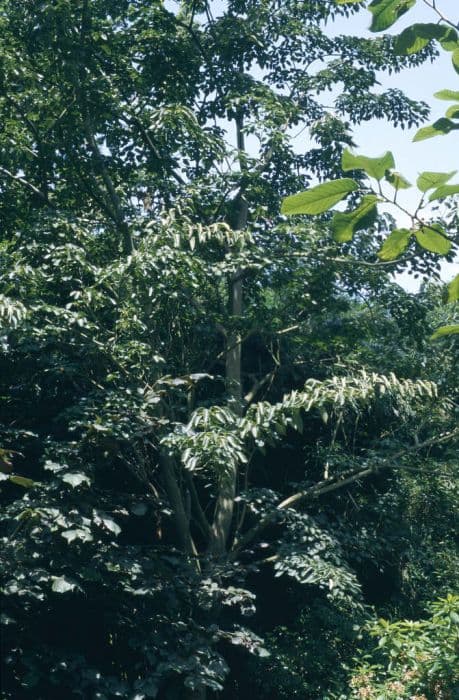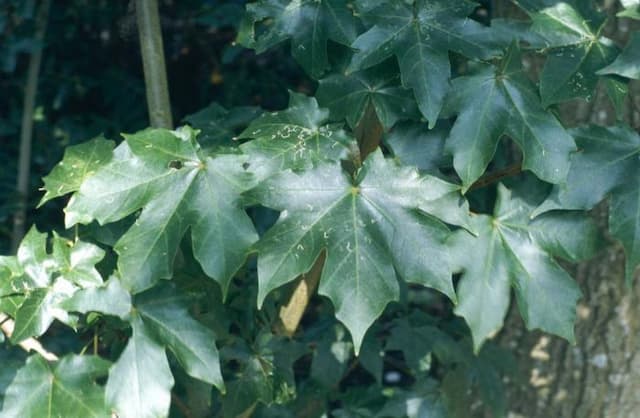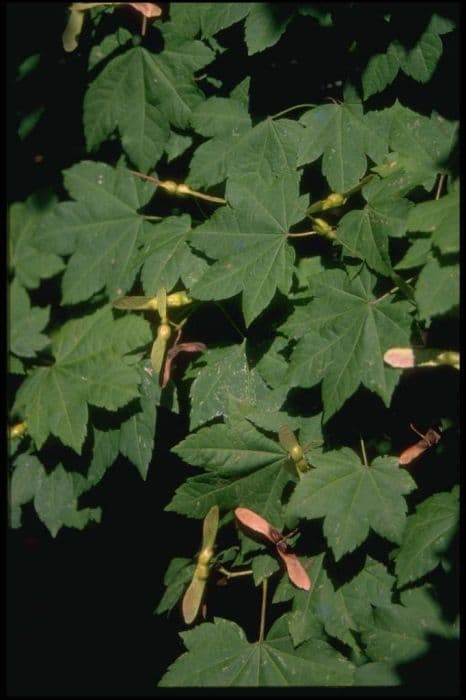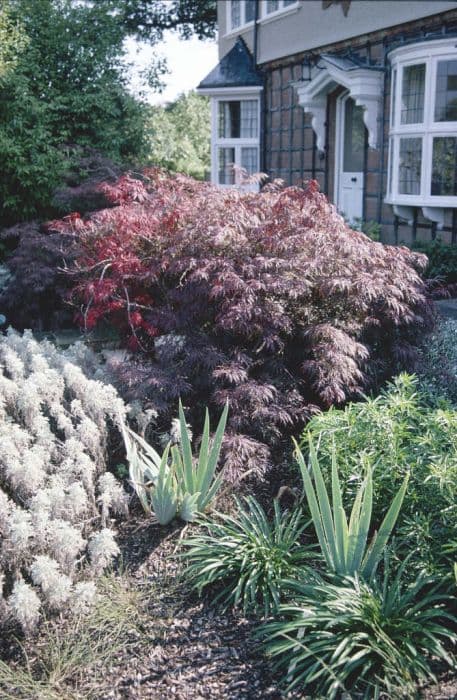Golden Cappadocian maple Acer cappadocicum 'Aureum'

ABOUT
'Aureum' is a broad-crowned, medium-sized deciduous tree. Leaves broad, 5-lobed, bright yellow when young, becoming green in summer, yellow in autumn. Flowers small, yellow
About this plant
 Names
NamesFamily
Sapindaceae
Synonyms
Golden Cappadocian Maple, Aureum Cappadocian Maple
Common names
Acer cappadocicum 'Rubrum', Acer laetum var. rubrum, Acer cappadocicum var. rubrum.
 Characteristics
CharacteristicsLife cycle
Perennials
Foliage type
Deciduous
Color of leaves
Yellow-green
Flower color
Yellow-green
Height
20-35 feet (6-11 meters)
Spread
20-30 feet (6-9 meters)
Plant type
Tree
Hardiness zones
5
Native area
Asia
Benefits
 General Benefits
General Benefits- Ornamental Appeal: The Golden Cappadocian maple, particularly this cultivar 'Aureum', is prized for its bright yellow-green foliage that adds striking color contrast in gardens and landscapes.
- Shade Provision: As a medium-sized deciduous tree, it provides ample shade during the hot months, making it a practical choice for parks and large gardens.
- Seasonal Interest: This maple offers seasonal interest with its leaves that turn attractive shades of yellow or golden in the fall before they drop.
- Wildlife Support: The tree can support local ecosystems by providing habitat and food for wildlife, such as birds and beneficial insects.
- Low Maintenance: Once established, the Golden Cappadocian maple requires minimal care, making it a good choice for those seeking a low-maintenance landscape option.
- Adaptability: It can adapt to a variety of soil types, though it prefers well-drained soils, and can tolerate some degree of urban pollution.
- Drought Tolerance: After establishment, the tree has a moderate tolerance to drought, reducing the need for frequent watering.
- Longevity: Maples generally have a long lifespan, which allows for long-term planning in landscape design and provides a long-lasting addition to any space.
 Medical Properties
Medical PropertiesThis plant is not used for medical purposes.
 Air-purifying Qualities
Air-purifying QualitiesThis plant is not specifically known for air purifying qualities.
 Other Uses
Other Uses- Acer cappadocicum 'Aureum', commonly known as the Golden Cappadocian Maple, can be utilized in bonsai cultivation, where its attractive foliage and relatively flexible branches allow enthusiasts to shape it into miniature tree forms.
- In landscape design, the Golden Cappadocian Maple can serve as a natural privacy screen due to its dense growth, especially when planted in a row or as part of a mixed hedge.
- The tree may also be involved in educational projects or activities that teach about autumnal color changes and chlorophyll breakdown in deciduous trees, as it is known for its vibrant seasonal transitions.
- Wood from the Golden Cappadocian Maple can be crafted into specialty wood items such as instruments or fine woodturning projects, where its wood aesthetics are highly appreciated.
- The tree's broad canopy offers a hospitable environment for treehouses or children's play structures, blending fun with the natural landscape.
- Due to its strong, upright growth, the Golden Cappadocian Maple can be used as a support structure for climbing plants and vines, creating a living archway or garden feature.
- The dried leaves of the Golden Cappadocian Maple can be used in crafts, such as leaf pressing or for creating natural motifs in homemade paper making.
- Photographers may seek out the Golden Cappadocian Maple for its aesthetic qualities, using it as a dynamic subject or backdrop during the golden hour for enhanced natural coloration in photos.
- Fallen leaves from the tree can be collected and used as a natural mulch, providing nutrients back to the soil as they decompose and improving garden health.
- In urban planning, the tree is sometimes used to soften the hard architecture of cityscapes, its yellow foliage offering a striking contrast against concrete and steel.
Interesting Facts
 Feng Shui
Feng ShuiThe Golden Maple is not used in Feng Shui practice.
 Zodiac Sign Compitability
Zodiac Sign CompitabilityThe Golden Maple is not used in astrology practice.
 Plant Symbolism
Plant Symbolism- Growth and Renewal: The Acer cappadocicum 'Aureum', commonly known as the Golden Cappadocian Maple, often symbolizes growth and renewal due to its deciduous nature and fresh leaves that appear each spring.
- Strength and Endurance: As a maple species, it represents strength and endurance because maples are known for their sturdy wood and their ability to withstand various climates.
- Beauty and Grace: The Golden Cappadocian Maple is also associated with beauty and grace, as its golden-yellow foliage provides an elegant display in landscapes and gardens.
- Adaptability: This plant can symbolize adaptability since it can grow in various soil types and conditions, which can remind us of the importance of being flexible and adaptable in life.
- Wisdom: In some cultures, maples are considered symbols of wisdom, attributed to their longevity and the intricate patterns of their leaves.
 Water
WaterGolden Maple trees should be watered deeply and less frequently to encourage strong root systems. They should typically receive about 1 to 1.5 inches of water each week, which translates to approximately 10-15 gallons for a young tree. During hot and dry periods, they may need water twice a week, while in cooler, wetter seasons, they may need less frequent watering. It is best to water the tree slowly, allowing moisture to soak into the ground without runoff. Adjust your watering to the tree's growth rate and the weather conditions, watering less in the fall and winter when the tree is dormant.
 Light
LightGolden Maple prefers a spot in full sun to partial shade. A location with morning sun and afternoon shade is ideal, as this can help prevent leaf scorch during the hottest part of the day. However, the tree is adaptable and can thrive in a variety of light conditions as long as it receives at least four hours of direct sunlight each day.
 Temperature
TemperatureGolden Maples can tolerate a range of temperatures but grow best where summer conditions are not excessively hot. They can handle minimum winter temperatures down to -30°F and are hardy to USDA zones 4 through 7. The ideal temperature range for the Golden Maple would be between 50°F and 70°F. Extreme heat may stress the tree, so in hotter regions, providing some afternoon shade will help protect it.
 Pruning
PruningPruning Golden Maple should be done to remove dead or damaged branches, to shape the tree, and to encourage healthy growth. The best time for pruning is late winter or early spring before the sap starts to flow. Pruning should be done annually for young trees, shaping them as they grow, and less frequently for mature trees unless there are specific issues that need to be addressed.
 Cleaning
CleaningAs needed
 Soil
SoilThe Golden Cappadocian Maple prefers a well-draining, fertile soil with a slightly acidic to neutral pH between 5.5 and 7.0. A suitable soil recipe could be a mix of loam, peat, and coarse sand or perlite in equal parts, ensuring good aeration and drainage.
 Repotting
RepottingGolden Cappadocian Maples grown in containers may need repotting every 2-3 years, ideally in the early spring before the growing season begins, to provide fresh nutrients and additional space for root growth.
 Humidity & Misting
Humidity & MistingThe Golden Cappadocian Maple thrives in average outdoor humidity levels, without the need for specific humidity adjustments.
 Suitable locations
Suitable locationsIndoor
Bright, indirect light; avoid dry radiators.
Outdoor
Full sun to partial shade; shelter from harsh winds.
Hardiness zone
5-7 USDA
 Life cycle
Life cycleThe life of the Golden Cappadocian Maple (Acer cappadocicum 'Aureum') begins with seed germination, after which the seedling emerges and starts to develop its first leaves. As the plant enters the juvenile stage, it grows rapidly and starts to form a small trunk and branches, displaying its characteristic golden-yellow foliage in spring. During the mature stage, this maple will produce flowers in early spring, followed by the development of its distinctive winged samaras, or helicopter seeds, which disperse by wind. The tree continues to grow in height and girth, and reaches reproductive maturity within 20 to 30 years, where it can then produce seeds annually. This deciduous tree experiences a period of dormancy each winter, during which it sheds its leaves, and then resumes growth in the spring. The Golden Cappadocian Maple can live for several decades, potentially over a century, continuing its cycle of growth, reproduction, and dormancy.
 Propogation
PropogationPropogation time
Spring-Early Summer
The Acer cappadocicum 'Aureum', commonly known as the Golden Cappadocian Maple, is typically propagated by seed or by grafting. The most popular method is through grafting, which is generally performed in late winter or early spring. During this process, a cutting from a healthy Golden Cappadocian Maple is joined to a compatible rootstock. The key to successful grafting is ensuring clean cuts and a snug fit between the scion (the cutting) and the rootstock so that the cambium layers – the actively growing part of the stem – align well, which encourages the formation of a strong union. The joined pieces are then securely wrapped and left undisturbed to allow the graft to take, a process that may take several weeks. Proper aftercare, such as maintaining adequate moisture levels and protecting the new graft from extreme weather conditions, is essential to give the new tree the best chance of healthy growth.








